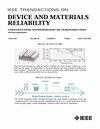揭示聚合物热界面材料在热氧化条件下的降解机理
IF 2.5
3区 工程技术
Q2 ENGINEERING, ELECTRICAL & ELECTRONIC
IEEE Transactions on Device and Materials Reliability
Pub Date : 2024-08-15
DOI:10.1109/TDMR.2024.3442781
引用次数: 0
摘要
随着电子器件功率密度和小型化程度的不断提高,其热管理和可靠性变得越来越重要。聚合物基热界面材料用于填补芯片与散热器之间的空隙,对散热起着重要的作用,但学术界对其可靠性的研究很少,特别是在热氧化条件下。本文以高填充导热凝胶为模型,研究了聚合物基热界面材料在热氧化条件下的降解机理。结果表明,时效主要是使材料的力学性能下降,而不是使其固有导热系数下降。时效试样的断裂伸长率随时效时间的增加而降低,相应的模量随时效时间的增加而增加。弛豫谱表明,老化试样的弛豫时间增加。老化样品的弛豫时间较长是由于界面上烷烃链的断裂和氧化以及聚二甲基硅氧烷链的解聚,导致聚合物网络交联程度较高。因此,聚合物的界面老化和解聚都有助于减缓聚合物链动力学和力学性能的退化。这项工作为深入了解热界面材料的降解机理提供了依据,并为高可靠性热界面材料的开发提供了指导。本文章由计算机程序翻译,如有差异,请以英文原文为准。
Unveiling the Degradation Mechanism of Polymer-Based Thermal Interface Materials Under Thermo-Oxidative Condition
With the growing power density and miniaturization of electronic devices, their thermal management and reliability are becoming more and more important. Polymer-based thermal interface materials, which are used to fill the gap between chip and heat sink, play an important role for the heat dissipation, but their reliability is rarely studied in academia, especially under thermo-oxidative condition. Here, a polymer-based thermal interface material, highly filled thermal conductive gel, is used as a model to study the degradation mechanism under thermo-oxidative condition. The results show that aging mainly deteriorates the mechanical performance instead of its intrinsic thermal conductivity. The elongation at break of aged sample is reduced and the corresponding modulus is increased as a function of aging time. Relaxation spectra indicate that the relaxation time of aged sample increases. The longer relaxation time of aged sample is attributed to the chain scission and oxidation of alky chain at interface and the depolymerization of polydimethylsiloxane chain, resulting in a more crosslinked polymer network. Thus, both interfacial aging and depolymerization of polymers contribute to the slowdown of polymer chain dynamics and degradation of mechanical properties. This work provides an insight into the degradation mechanism of thermal interface materials and guides the development of high-reliability thermal interface materials.
求助全文
通过发布文献求助,成功后即可免费获取论文全文。
去求助
来源期刊

IEEE Transactions on Device and Materials Reliability
工程技术-工程:电子与电气
CiteScore
4.80
自引率
5.00%
发文量
71
审稿时长
6-12 weeks
期刊介绍:
The scope of the publication includes, but is not limited to Reliability of: Devices, Materials, Processes, Interfaces, Integrated Microsystems (including MEMS & Sensors), Transistors, Technology (CMOS, BiCMOS, etc.), Integrated Circuits (IC, SSI, MSI, LSI, ULSI, ELSI, etc.), Thin Film Transistor Applications. The measurement and understanding of the reliability of such entities at each phase, from the concept stage through research and development and into manufacturing scale-up, provides the overall database on the reliability of the devices, materials, processes, package and other necessities for the successful introduction of a product to market. This reliability database is the foundation for a quality product, which meets customer expectation. A product so developed has high reliability. High quality will be achieved because product weaknesses will have been found (root cause analysis) and designed out of the final product. This process of ever increasing reliability and quality will result in a superior product. In the end, reliability and quality are not one thing; but in a sense everything, which can be or has to be done to guarantee that the product successfully performs in the field under customer conditions. Our goal is to capture these advances. An additional objective is to focus cross fertilized communication in the state of the art of reliability of electronic materials and devices and provide fundamental understanding of basic phenomena that affect reliability. In addition, the publication is a forum for interdisciplinary studies on reliability. An overall goal is to provide leading edge/state of the art information, which is critically relevant to the creation of reliable products.
 求助内容:
求助内容: 应助结果提醒方式:
应助结果提醒方式:


